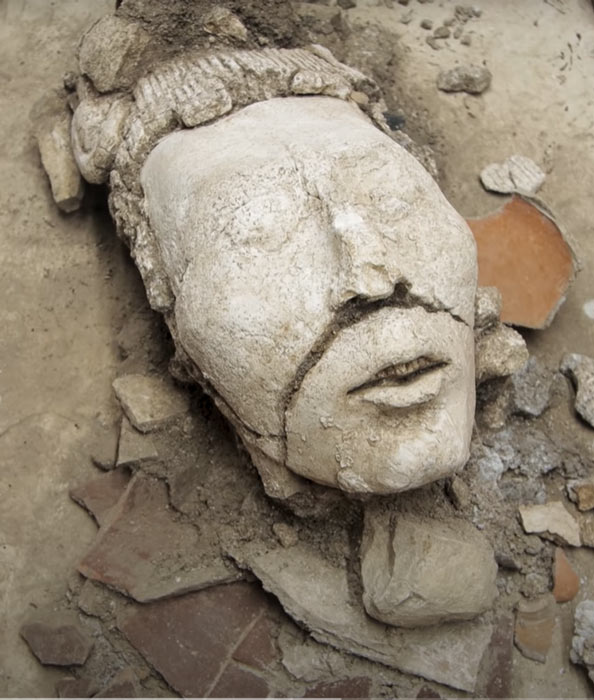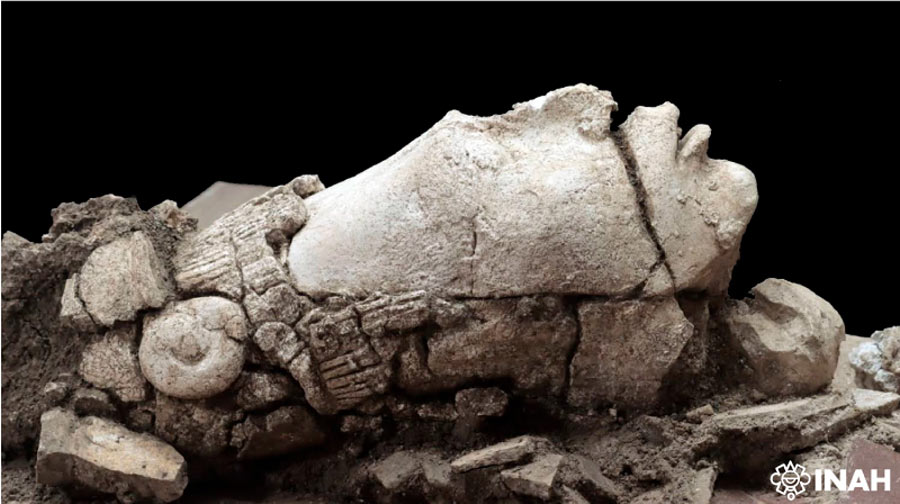1300-Year-Old Severed Head Sculpture Located in the ‘Lost City’ of Maya
The first published European account of the lost city of Palenque is from 1567, by the Spaniard, Father Pedro Lorenzo de la Nada, who found this vast abandoned Maya city. The local Chol Maya called it “Otolum” or “a land with strong houses,” which the Spanish translated into Palenque, the Spanish word for fortification. Now specialists from the National Institute of Anthropology and History (INAH) have discovered a first-of-its-kind representation of the “young corn god” of maize in the vast ruins of Palenque, Mexico reports AFP.
This is the first time that a stuccoed head of this important deity from the Maya pantheon has been found at Palenque. Located near the Usumacinta River, Palenque is renowned for the outstanding quality of its Maya architecture, sculpture, roof combs, and bas-relief carvings.

The recently discovered young corn god head was one of many heads that adorned the facades and ceremonial rooms at Palenque. This is a bas-relief carving of a Maya king at Palenque. (frenta / Adobe Stock)
The Young Corn God Head Sheds New Light on Palenque Maya
The ruins of Palenque are stunning and vast, and only 10% of them have been carefully examined. The amazing structures explored at Palenque so far include the Temple of Inscriptions, Temple of the Cross group, the Red Queen skull burial chamber, and the palace complex. These enormous structures are surrounded by forests echoing with the eerie cries of howler monkeys. There are roughly 1,400 documented structures scattered over the roughly 1,800 hectares (about 4,400 acres) site.
- Mayan Child Sacrifices with ‘Divine’ Obsidian and Jade Discovered in Guatemala
- Maya Gateway to the World Below: Balankanché Cave, Throne of the Tiger Priest
In July of 2021 the INAH set up an interdisciplinary team, co-led by archaeologist Arnoldo González Cruz, a researcher at the INAH Chiapas Center (whose also renowned for the salvage work performed on the Red Queen), and restorer Haydeé Orea Magaña. While working at Palenque, the INAH team discovered a rather deliberate alignment of stones in a corridor that connected House B of the palace, with adjacent House F.
When they removed the dirt and fill under the corridor, they found a receptacle which contained a severed stucco head in a small pond. First, the nose and half-open mouth of the divinity emerged. It was placed like an offering on the pond floor, enclosed in stuccoed walled enclosure measuring 1 x 3 meters (3.2 x 9.8 feet). This was probably done to simulate the entry of gods to the underworld in an aquatic environment, as per the INAH press release.

The stuccoed young corn god head as it was discovered in the stucco-walled pond while the INAH team was following a corridor between two rooms in the vast ruins of Palenque. (YouTube screenshot / INAH)
The Stuccoed Young Maize God Head Was Aligned East to West
"The discovery of the deposit allows us to begin to know how the ancient Maya of Palenque constantly relived the mythical passage about the birth, death and resurrection of the maize deity," added González Cruz.
His colleagues Carlos Varela Scherrer and Wenceslao Urbina Cruz, who worked on this project as field chiefs, added that the stuccoed head, 45 x 16 x 22 centimeters (18 x 6 x 8.7 inches), was purposely aligned east to west. This was done to symbolically mark the birth of the corn plant with the first rays of the sun. The sculpture was placed on a ceramic tripod, also found at the site.
The iconographic style of the Palenque young corn god was almost identical to the Tikal severed heads from the Late Classic (600-850 AD) and Early Classic (150-600 AD) periods. The Palenque head has been dated to the Late Classic period (700-850 AD).
“The sculpture, which must have been modeled around a limestone support, has graceful features: the chin is sharp, pronounced and split; the lips are thin and projecting outwards – the lower one slightly downwards – and show the upper incisors. The cheekbones are fine and rounded; and the eyes, elongated and thin. From the wide, long, flattened and rectangular forehead, a wide and pronounced nose is born,” summarized archaeologists Scherrer and Urbina Cruz.

According to INAH archaeologist Arnoldo González, this newly-revealed Palenque pond, where the young corn god’s severed head was found, was used as a mirror to reflect the Maya cosmos in nocturnal rituals. (INAH)
Nature’s Elements and Maya Philosophy
As per Maya philosophy, which flourished and developed at the time that Europe was still in the Dark Ages, the Maya saw the universe as a trifecta. It was divided into the sky, the earth, and the underworld.
Caves and cenotes would serve as gateways to Xibalba, which was a subterranean realm ruled by the Maya gods of death. According to archaeologist González Cruz, the recently revealed Palenque pond was used as a mirror to reflect the cosmos in a nocturnal ritual. These ideas developed in the early 7th century AD under ajaw-ruler K’inich Janaab’ Pakal I (615-683 AD) and continued in rituals for almost 200 years.
- Ix Chel’s Coiled Snake Headdress: Sacred Symbol of Maya Women
- Precise Teotihuacan Replicas Found With LiDAR at Maya City of Tikal
Towards the 8th century, the space was closed in a symbolic way, and a portion of the stucco floor was removed. The removed portion was filled in with vegetables, animal bones, shells, ceramic pieces, obsidian blades, seeds, and beads. On top of this a limestone slab was placed, guarded by a bed of potsherds and small stones, where the young corn god deity would be placed and supported. The entire space was then closed off, leaving the head of the young maize god inside a box. It remained hidden there for nearly 1,300 years.
“The placement of these elements was constituted concentrically and not by layers, covering almost 75% of the cavity, which was sealed with loose stones. Some animal bones were cooked, and others have meat marks and tooth prints, so they were used for human consumption as part of the ritual,” Cruz concluded.
Moving forward, the head has been transferred to INAH headquarters, where it will be dried (due to the high humidity of its resting place) before further examinations are carried out.
Top image: The first ever stylistic representation of the “young corn god” of the Maya, from the 7th century, recently discovered in a lost ritual pond in the vast remains of Palenque, Mexico. Source: INAH
By Sahir Pandey
References
AFP. 2022. Ancient Mayan maize god sculpture found in Mexico. Available at: https://www.france24.com/en/live-news/20220602-ancient-mayan-maize-god-sculpture-found-in-mexico.
Hearn, K. 2015. Palenque Prized for Unlocking Maya Mysteries. Available at: https://www.nationalgeographic.com/history/article/palenque.
INAH. 2022. They discover in Palenque a stuccoed head of the young maize god, linked to a ritual deposit. Available at: https://www.inah.gob.mx/boletines/11224-descubren-en-palenque-una-cabeza-estucada-del-joven-dios-del-maiz-vinculada-a-un-deposito-ritual.




















Comments
Yeah, it’s a head, but who built the structure and the pool, and how? Is it cement or cut into bedrock? And where’s the local quarry?
Nobody gets paid to tell the truth.